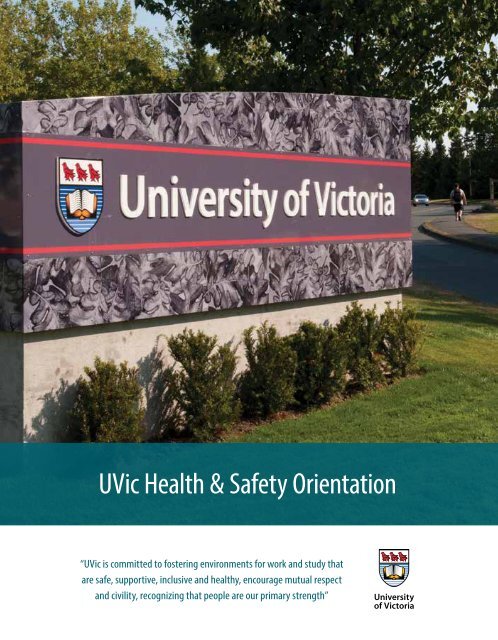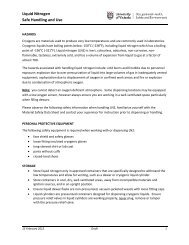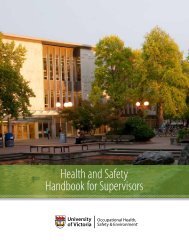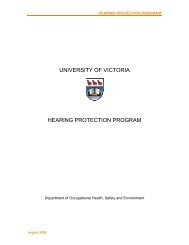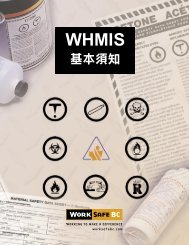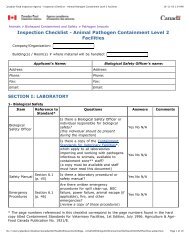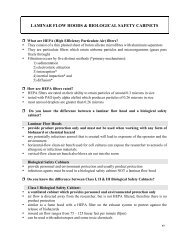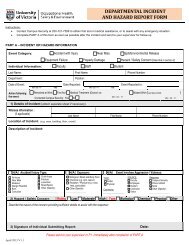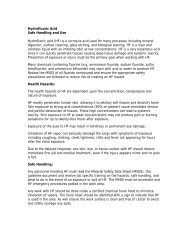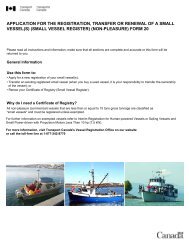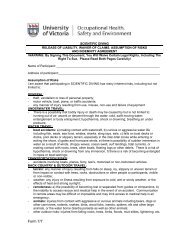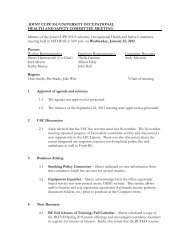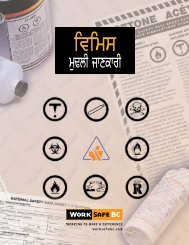UVic Health & Safety Orientation - Occupational Health and Safety
UVic Health & Safety Orientation - Occupational Health and Safety
UVic Health & Safety Orientation - Occupational Health and Safety
You also want an ePaper? Increase the reach of your titles
YUMPU automatically turns print PDFs into web optimized ePapers that Google loves.
<strong>UVic</strong> <strong>Health</strong> & <strong>Safety</strong> <strong>Orientation</strong><br />
“<strong>UVic</strong> is committed to fostering environments for work <strong>and</strong> study that<br />
are safe, supportive, inclusive <strong>and</strong> healthy, encourage mutual respect<br />
<strong>and</strong> civility, recognizing that people are our primary strength”
TABLE OF CONTENTS<br />
Introduction 2<br />
General Requirements<br />
<strong>Health</strong> <strong>and</strong> <strong>Safety</strong> Program 3<br />
Rights <strong>and</strong> Responsibilities 3<br />
Working Alone 4<br />
Prevention of Violence 4<br />
Bullying & Harrassment Prevention 5<br />
First Aid 6<br />
Incident Reporting 6<br />
Emergency Planning 7<br />
<strong>Health</strong> <strong>and</strong> <strong>Safety</strong> Committees 7<br />
WHMIS 8<br />
Ergonomics 8<br />
Environment 9<br />
Contact Information 9<br />
Job Specific Requirements<br />
<strong>Health</strong> <strong>and</strong> <strong>Safety</strong> Information 10<br />
Job Specific Training 10<br />
Checklist 11<br />
1 |
INTRODUCTION<br />
<strong>UVic</strong> <strong>Health</strong> <strong>and</strong> <strong>Safety</strong> <strong>Orientation</strong> is the first step to help prepare you for the job before you start<br />
working. The goals are to create an ongoing commitment to health <strong>and</strong> safety during your time at<br />
<strong>UVic</strong> <strong>and</strong> to ensure compliance with WorkSafeBC.<br />
How to Complete the <strong>Orientation</strong><br />
This h<strong>and</strong>book is divided into two sections:<br />
General Requirements: health <strong>and</strong> safety<br />
information applicable to every <strong>UVic</strong> employee.<br />
Please review this h<strong>and</strong>book to ensure that you have<br />
read <strong>and</strong> understood the general requirements. If<br />
you have any questions, please ask your supervisor<br />
for help.<br />
Job-Specific Requirements: health <strong>and</strong> safety<br />
information directly related to your job. Before you<br />
start working, your supervisor should identify <strong>and</strong><br />
explain any hazards associated with your job <strong>and</strong><br />
provide you with instructions on how to work safely.<br />
Your department should document this training<br />
<strong>and</strong> keep records onsite.<br />
Once you <strong>and</strong> your supervisor are satisfied that<br />
both general <strong>and</strong> job-specific requirements have<br />
been met, each of you must sign-off using the<br />
online form*.<br />
Who is a Supervisor?<br />
A supervisor is anyone who instructs, directs <strong>and</strong><br />
manages employees in the performance of their<br />
duties. At <strong>UVic</strong> this will include people who are<br />
employed as Directors, Managers <strong>and</strong> Supervisors<br />
as well as Deans, Chairs, Principal Investigators,<br />
Administrative Officers <strong>and</strong> Lab Instructors.<br />
All supervisors should be familiar with this h<strong>and</strong>book<br />
<strong>and</strong> ensure that health <strong>and</strong> safety is an integral part<br />
of their department’s orientation process.<br />
Supervisors should also review the <strong>Health</strong> <strong>and</strong> <strong>Safety</strong><br />
H<strong>and</strong>book for Supervisors which outlines specific<br />
duties <strong>and</strong> accountablities for supervisory staff.<br />
*Note: Casual employees without a “regular” appointment are not required to sign-off using the online form. Instead, your department<br />
should document that orientation has been completed using the checklist at the end of this h<strong>and</strong>book or download as a<br />
pdf. For more information see the <strong>Health</strong> <strong>and</strong> <strong>Safety</strong> FAQ’s.<br />
| 2
GENERAL REQUIREMENTS<br />
<strong>Health</strong> <strong>and</strong> <strong>Safety</strong> Programs<br />
The foundation of successful health <strong>and</strong> safety programs is a comprehensive Environmental <strong>Health</strong> <strong>and</strong><br />
<strong>Safety</strong> Management System (EHSMS). At <strong>UVic</strong> the EHSMS integrates all aspects of safety programs, activities,<br />
procedures, roles <strong>and</strong> responsibilities <strong>and</strong> assessment of health <strong>and</strong> safety performance.<br />
Key principles of the EHSMS include:<br />
• internal (shared) responsibility for health <strong>and</strong> safety<br />
• due diligence for regulatory compliance<br />
• integration of health <strong>and</strong> safety practice into all work activities<br />
• continuous health <strong>and</strong> safety monitoring <strong>and</strong> improvement<br />
• respecting the independence of research <strong>and</strong> teaching<br />
Please review the University’s Policy on Environmental <strong>Health</strong> <strong>and</strong> <strong>Safety</strong> for more information about your<br />
roles <strong>and</strong> responsibilities, <strong>and</strong> resources that support health <strong>and</strong> safety management.<br />
Rights <strong>and</strong> Responsibilities<br />
As an employee of <strong>UVic</strong>, you have the right to:<br />
• be informed about workplace hazards <strong>and</strong> participate in inspections, committees <strong>and</strong> other health <strong>and</strong><br />
safety activities.<br />
• refuse unsafe work <strong>and</strong> not be subject to discriminatory actions. Discriminatory actions include<br />
suspension, layoff <strong>and</strong> dismissal; demotion; wage reduction or change in working hours; coercion <strong>and</strong><br />
disciplinary action.<br />
As an employee of <strong>UVic</strong>, you have the responsibility to:<br />
• follow <strong>UVic</strong> policies <strong>and</strong> procedures <strong>and</strong> to work in compliance with all applicable laws <strong>and</strong> regulations.<br />
• report any unsafe act or condition immediately to your supervisor, who will then investigate <strong>and</strong> take<br />
corrective action as required.<br />
• ensure you have the necessary training, assistance <strong>and</strong> equipment before beginning a job.<br />
3 |
Working Alone<br />
To work alone or in isolation means to work in circumstances where assistance would not be readily available<br />
in case of emergency, injury or ill health.<br />
Working alone requirements will not apply to most groups on campus since assistance is readily available<br />
through the presence of others <strong>and</strong> Campus Security’s 24-hour first aid response, <strong>and</strong> the work is considered<br />
low hazard.<br />
Some departments may need to develop a written Working Alone Plan if work activities are moderately<br />
hazardous <strong>and</strong> you are required to work alone for all or parts of your job. This Plan would include:<br />
• establishing a regular time-interval between “check-ins”<br />
• designating a person to establish contact with the employee at predetermined intervals,<br />
<strong>and</strong> to record the results<br />
• developing a follow-up procedure in case the employee cannot be contacted.<br />
In general, employees should not work alone in any situation involving the use of hazardous materials, high<br />
voltage, confined spaces or other high hazard activities.<br />
For more details, please review the Working Alone information on the OHSE website.<br />
Also review the Campus Alone program offered by Campus Security (CSEC).<br />
Prevention of Violence<br />
Certain jobs <strong>and</strong> work environments may present a risk of injury to employees arising from violence. Risk<br />
factors include activities where employees interact with members of the public, h<strong>and</strong>le money in retail<br />
settings or work after-hours.<br />
Violence in the workplace means any physical force, threatening statements or behaviour, attempted or actual,<br />
which causes injury or gives the employee reasonable cause to believe he or she is at risk of injury.<br />
At <strong>UVic</strong>, any violent incidents or concerns about suspicious behavior, theft or personal safety should be<br />
reported immediately to Campus Security <strong>and</strong> your supervisor for follow-up. If the issue involves allegations<br />
of workplace bullying <strong>and</strong> harassment the supervisor or department should be notified <strong>and</strong> is required to take<br />
initial steps to investigate.<br />
If there exists an identified risk of injury from violence, your department must establish procedures to control<br />
the risk. For more details, please review the Prevention of Violence information on the OHSE website.<br />
Also review the information provided by CSEC on Personal Security.<br />
| 4
Bullying <strong>and</strong> Harassment Prevention<br />
The university is committed to maintaining a healthy, safe <strong>and</strong> respectful environment for work <strong>and</strong> study. It<br />
is the responsibility of all members of the campus community not to engage in bullying <strong>and</strong> harassment, to<br />
report any bullying <strong>and</strong> harassment they observe or experience, <strong>and</strong> to comply with <strong>UVic</strong> <strong>and</strong> WorkSafeBC<br />
(WSBC) policies <strong>and</strong> procedures on bullying <strong>and</strong> harassment.<br />
Definition of bullying <strong>and</strong> harassment (WSBC)<br />
Includes any inappropriate conduct or comment by a person towards a worker that the person knew or<br />
reasonably ought to have known would cause that worker to be humiliated or intimidated, but excludes any<br />
reasonable action taken by an employer or supervisor relating to the management <strong>and</strong> direction of workers<br />
or the place of employment.<br />
Includes (but not limited to)<br />
• Verbal aggression, yelling or insults<br />
• Humiliating initiation practices or hazing<br />
• Spreading malicious rumours<br />
• Calling someone derogatory names<br />
• V<strong>and</strong>alizing a worker’s belongings<br />
• Sabotaging a person’s work<br />
• Engaging in targeted social isolation<br />
Does Not Include<br />
• Expressing differences of opinion<br />
• Work instruction, supervision, or feedback<br />
• Job duties or work to be performed<br />
• Performance management<br />
• Assigning work, workloads <strong>and</strong> deadlines<br />
• Layoffs, transfers <strong>and</strong> reorganizations<br />
• Discipline, suspension, or termination<br />
Reporting Procedures<br />
Report any incidents or complaints to your direct supervisor or to the Equity <strong>and</strong> Human Rights office<br />
(EQHR).<br />
If the complainant’s direct supervisor is the person engaging in alleged bullying <strong>and</strong> harassing behaviour,<br />
contact another manager in your department, EQHR, your union or employee representative, a Human<br />
Resources Consultant, VPAC Faculty Relations, Campus Security Services or <strong>Occupational</strong> <strong>Health</strong>, <strong>Safety</strong> <strong>and</strong><br />
Environment for assistance.<br />
Incidents or complaints should be reported as soon as possible after experiencing or witnessing bullying <strong>and</strong><br />
harassment. This allows the incident to be investigated <strong>and</strong> addressed promptly.<br />
Provide as much information as possible in your report, such as the names of people involved, witnesses,<br />
where the events occurred, when they occurred, <strong>and</strong> what behaviour <strong>and</strong>/or words led to the complaint.<br />
Follow-up<br />
It is expected that supervisors will address any reported complaints within their department <strong>and</strong> are<br />
encouraged to seek advice <strong>and</strong> assistance from a Human Resources Consultant, VPAC Faculty Relations or<br />
EQHR, as appropriate.<br />
For more information about bullying <strong>and</strong> harassment prevention including policies, toolkits, fact sheets,<br />
education, <strong>and</strong> WSBC claims please visit ohs.uvic.ca/bullying<strong>and</strong>harassment.php<br />
5 |
Emergencies<br />
In all emergency situations requiring ambulance, fire or police call 911.<br />
Remember to always provide your name <strong>and</strong> campus location including the<br />
building <strong>and</strong> room number. Campus Security can also be contacted to assist in<br />
any emergency situation by calling 250-721-7599.<br />
First Aid<br />
Campus Security provides First Aid response for all members of the campus<br />
community, 24-hours a day, by calling 250-721-7599.<br />
Reporting Hazards or <strong>Safety</strong> Concerns<br />
Faculty, staff <strong>and</strong> students must report any non-emergency hazards or safety<br />
concerns to their supervisor for follow-up. If their supervisor is not available,<br />
then they should report the concern to another management representative<br />
from their department, their union representative or local safety committee,<br />
Campus Security or OHSE. Follow this link for more information on Hazard<br />
Reporting.<br />
Reporting Incidents <strong>and</strong> Injuries<br />
When an incident occurs contact Campus Security to obtain first aid, other<br />
medical aid or to assist with an emergency situation. All accidents, incidents<br />
<strong>and</strong> near-misses must then be reported as soon as possible to a supervisor<br />
using the Departmental Incident <strong>and</strong> Hazard Report form. Incidents that<br />
result in the following must be reported <strong>and</strong> investigated by the Department:<br />
• Injury, Exposure or <strong>Occupational</strong> Disease<br />
• Time-loss from work<br />
• Medical treatment (by a medical practitioner)<br />
• First Aid call-out (for work-related injuries)<br />
• Near-miss (no injury but potential to cause serious injury)<br />
• Equipment failure<br />
• Hazardous material spill/environmental release<br />
• Property damage<br />
Minor incidents not meeting any of the above criteria should be recorded in<br />
the Departmental Accident Record book.<br />
WorkSafeBC Claims<br />
If your injury results in a WorkSafeBC claim, you must also complete an<br />
Employee’s Report of Injury (Form 6A) <strong>and</strong> contact WorkSafeBC to initiate your<br />
claim. All incidents require follow-up investigation by your supervisor <strong>and</strong> joint<br />
local safety committee review.<br />
Follow these links for more information on Incident Reporting <strong>and</strong><br />
WorkSafeBC Claims.<br />
| 6
Emergency Planning<br />
Emergency Planning on campus focuses on building our capacity to<br />
respond to <strong>and</strong> recover quickly from a major emergency or disaster.<br />
Everyone at <strong>UVic</strong> has a role to play.<br />
Key information is found in the<br />
University’s Emergency Procedures poster.<br />
Other important information:<br />
• Each building has a team of Emergency Coordinators who will assist<br />
in the event of an evacuation (team members can be identified by<br />
orange vests labeled with ‘UVIC’ <strong>and</strong> specific building names).<br />
• Familiarize yourself with the location of fire alarm pull stations <strong>and</strong><br />
fire extinguishers in your workplace(s).<br />
• Know the location of Emergency Assembly Points (where you will<br />
meet during a building evacuation).<br />
• In the event of a major damaging earthquake we may need to<br />
evacuate the campus.<br />
Review the campus evacuation procedures <strong>and</strong> learn about the<br />
campus assembly area<br />
• <strong>UVic</strong> uses a messaging system to send emergency information to<br />
campus e-mails, telephones, mobile phone numbers <strong>and</strong> Twitter.<br />
For more information <strong>and</strong> to register your mobile please visit the<br />
<strong>UVic</strong> Alerts website.<br />
• Always contact 911 (or 9-911) or CSEC to report an emergency<br />
situation. Remember to provide your name <strong>and</strong> exact location.<br />
For additional emergency planning information visit<br />
www.uvic.ca/services/emergency<br />
Joint <strong>Health</strong> <strong>and</strong> <strong>Safety</strong> Committees<br />
<strong>Health</strong> <strong>and</strong> safety committees play a key role in the university’s safety<br />
management system. Joint Local <strong>Safety</strong> Committees (LSC) meet on<br />
a monthly basis <strong>and</strong> represent all units <strong>and</strong> workplaces on campus as<br />
required by WorkSafeBC.<br />
LSC’s are made up of staff <strong>and</strong> management representatives working<br />
cooperatively in support of a comprehensive occupational health <strong>and</strong><br />
safety program. As a joint committee, it represents an excellent means<br />
of consultation within the organization to review health <strong>and</strong> safety<br />
programs, establish proactive communication, <strong>and</strong> assist the employer<br />
with reducing/eliminating workplace accidents <strong>and</strong> injuries.<br />
Please follow this link to learn more about Local <strong>Safety</strong> Committees,<br />
how they integrate with other safety committees on campus <strong>and</strong> their<br />
role in assisting with inspections <strong>and</strong> addressing safety concerns.<br />
7 |
WHMIS<br />
Employees who use controlled products must receive education <strong>and</strong> training in Workplace Hazardous Materials<br />
Information System (WHMIS) prior to starting their job.<br />
WHMIS contains three key elements: product labels, material safety data sheets (MSDS) <strong>and</strong> education <strong>and</strong><br />
training programs.<br />
Following successful WHMIS training, employees should be able to answer these questions:<br />
• What are the hazards of the products being used?<br />
• How do you protect yourself?<br />
• What should be done in case of emergency or spills?<br />
• Where do you get more information on the product?<br />
<strong>Occupational</strong> <strong>Health</strong>, <strong>Safety</strong> & Environment offers online <strong>and</strong> classroom-based WHMIS training for both lab<br />
workers <strong>and</strong> non-lab workers. An MSDS online database is available through OHSE.<br />
Ergonomics<br />
Ergonomics is concerned with identifying <strong>and</strong> minimizing risk factors to help prevent musculoskeletal injuries<br />
(MSI). These sprains, strains <strong>and</strong> other types of injuries can be caused or aggravated by work <strong>and</strong> may affect<br />
the muscles, soft tissues, <strong>and</strong> joints.<br />
Common ergonomic risk factors include force, repetition <strong>and</strong> awkward posture.<br />
Creating a good ergonomic work environment requires proper selection <strong>and</strong> use of tools <strong>and</strong> equipment,<br />
workstation layout <strong>and</strong> seating, <strong>and</strong> appropriate job practices to help maximize employee comfort <strong>and</strong> productivity.<br />
For more details, please review the Ergonomics information on the OHSE website.<br />
OHSE also offers office ergonomics <strong>and</strong> manual h<strong>and</strong>ling training to help supervisors <strong>and</strong> employees<br />
incorporate ergonomic practices in their work. These sessions are highly recommended for every new<br />
employee as part of your health <strong>and</strong> safety orientation. To register, please visit the OHSE Training <strong>and</strong><br />
Events website.<br />
| 8
Environment<br />
Environmental programs focus on pollution prevention,<br />
compliance <strong>and</strong> stewardship. A variety of programs <strong>and</strong><br />
services support environmental protection on campus.<br />
Hazardous Waste Management<br />
This program is designed to deal with any hazardous waste<br />
on campus so that no controlled products are released to<br />
the sewer or the regular garbage. OHSE supplies a variety of<br />
reusable containers for waste collection. Please use the online<br />
form to request a pick-up of your hazardous wastes.<br />
Spill Prevention <strong>and</strong> Response<br />
Plan your work to minimize the chance of a spill <strong>and</strong> have spill<br />
response equipment nearby (e.g. spill pads, absorbent, gloves,<br />
etc.) In the event of a spill, follow the information in the<br />
Spill Response Plan. If at any time you require assistance with<br />
a hazardous materials spill, please call Campus Security.<br />
Sustainability<br />
There are initiatives that encourage recycling, bicycle use,<br />
public transit <strong>and</strong> car sharing. You can find more information<br />
on the Sustainability website.<br />
University Smoking Policy<br />
The University has implemented a smoking policy in order<br />
to provide a safe <strong>and</strong> healthy environment on campus. This<br />
policy aims to control exposure to second-h<strong>and</strong> smoke by<br />
limiting smoking to designated areas outside Ring Road.<br />
Contact Information<br />
All employees should have the contact information for their<br />
supervisor on h<strong>and</strong> as well as the following numbers in case<br />
of emergency:<br />
Emergencies<br />
Fire, Ambulance, Police 911 or 9-911<br />
<strong>UVic</strong> Campus Security Services 250-721-7599<br />
Non-Emergencies<br />
<strong>UVic</strong> Campus Security Services 250-721-6683<br />
Saanich Police 250-475-4321<br />
Oak Bay Police 250-592-2424<br />
Saanich Fire Department 250-475-6111<br />
Oak Bay Fire Department 250-592-9121<br />
9 |
JOB SPECIFIC REQUIREMENTS<br />
<strong>Health</strong> <strong>and</strong> <strong>Safety</strong> Information<br />
Your supervisor is required to identify <strong>and</strong> explain any policies, rules <strong>and</strong> hazards associated with<br />
your job before you begin work, including:<br />
• General health <strong>and</strong> safety information such as keeping fire exits <strong>and</strong> hallways clear, incident<br />
reporting, first aid procedures <strong>and</strong> appropriate workplace conduct;<br />
• Departmental policies for operating machinery, hazardous materials use, working alone <strong>and</strong><br />
other activities that require Job Specific Training; <strong>and</strong><br />
• Selection, use <strong>and</strong> maintenance of any personal protective equipment (PPE) including protective<br />
clothing, headgear, eyewear, face shields, gloves, footwear or respirators.<br />
Job Specific Training<br />
Job Specific Training is the process of identifying hazardous work conditions <strong>and</strong> providing<br />
instruction to employees on safe work procedures by their supervisor or department.<br />
The instruction must be h<strong>and</strong>s-on <strong>and</strong> include a demonstration of the tasks <strong>and</strong> work processes<br />
you are required to perform as well as a review of written work procedures. A verbal description<br />
alone is not enough.<br />
You must also demonstrate that you can perform the task(s) safely. Your supervisor must assess your<br />
capability until you are both satisfied that the task can be performed safely.<br />
If the job scope changes (e.g. new equipment or work processes) all the steps shown above should<br />
be repeated to ensure that you are properly trained.<br />
All training must be documented, with records kept in your department.<br />
A sample template for job specific training can be found on the OHSE website. This template will<br />
assist in the identification of hazards <strong>and</strong> provide documentation that training has been completed.<br />
REMINDER: All regular appointed employees must complete the electronic sign-off once this<br />
h<strong>and</strong>book has been reviewed <strong>and</strong> initial job specific training has been provided.<br />
A health <strong>and</strong> safety checklist is also available for managers <strong>and</strong> supervisors to assist with the<br />
orientation process. Departments are encouraged to use this checklist <strong>and</strong> sign-off that orientation<br />
has been provided. Completed checklists should be kept with the department.<br />
| 10
NEW EMPLOYEE CHECKLIST<br />
Last Name:_________________________ First Name:_____________________ Phone Number:_________________<br />
Department:________________________ Position:________________________ Supervisor/P.I.:_________________<br />
Each new employee <strong>and</strong> their Supervisor/ P.I. should complete this checklist before the employee begins working<br />
independently in their area. After all topics have been reviewed <strong>and</strong> are clearly understood by the employee, please<br />
sign at the bottom of the form. Please retain a copy in your department (you do not need to send a copy to the OHSE<br />
Department)<br />
Emergency/ Evacuation<br />
Procedures<br />
√ General Policy/Programs √<br />
Employee Rights <strong>and</strong><br />
Responsibilities<br />
√<br />
Locations of:<br />
• Exits<br />
Reviewed Environmental<br />
<strong>Health</strong> <strong>and</strong> <strong>Safety</strong> Policy<br />
Right to refuse unsafe work without<br />
discriminatory actions<br />
• Fire Pull Stations<br />
University Smoking Policy<br />
Right to participate with inspections,<br />
committees <strong>and</strong> other safety activities<br />
• Fire Extinguishers<br />
Prevention of Violence/<br />
Bullying & Harassment<br />
Responsibility to report unsafe acts or<br />
conditions immediately to Supervisor<br />
• Emergency Assembly<br />
Points<br />
Working Alone Requirements<br />
Responsibility to follow University of<br />
Victoria Policies <strong>and</strong> Procedures<br />
Reviewed Earthquake<br />
Procedures<br />
Role of Campus Security<br />
(CSEC):<br />
• First Aid<br />
Documenting injury or near miss on<br />
Dept. Incident & Hazard Report Form<br />
Reviewed Emergency<br />
Procedures Poster<br />
• Accessing Safewalk/<br />
Campus Alone<br />
WorkSafeBC Claims Process<br />
• Personal Security<br />
Role of Joint <strong>Health</strong> <strong>and</strong><br />
<strong>Safety</strong> Committees<br />
Personal Protective<br />
Equipment (as applicable)<br />
√<br />
OHSE Departmental<br />
Training<br />
(check all that apply to position)<br />
√<br />
Departmental Specific Training<br />
(Please list safe operating procedures for<br />
specific equipment or processes)<br />
√<br />
Respirators<br />
Workplace Hazardous Materials<br />
Information System (WHMIS)<br />
Hearing Protection<br />
Transportation of Dangerous<br />
Goods (TDG)<br />
<strong>Safety</strong> Footwear<br />
Biosafety<br />
Gloves/ H<strong>and</strong><br />
Radiation <strong>Safety</strong><br />
Eye/Face Protection<br />
Laser <strong>Safety</strong><br />
<strong>Safety</strong> Headgear<br />
Fire Extinguishers<br />
Other:<br />
Ergonomics<br />
Employee Signature:________________________________________ Date: _____________________<br />
Supervisor/ P.I Signature:_____________________________________ Date:______________________<br />
11 |
ohs.uvic.ca<br />
Graphic Design: <strong>UVic</strong> Graphic Services | Photos: <strong>UVic</strong> Photo Services <strong>and</strong> Campus Security


